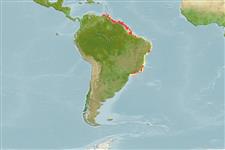Environment: milieu / climate zone / depth range / distribution range
Ekologi
laut; air tawar; payau; kisaran kedalaman ? - 40 m (Ref. 188). Tropical; 12°N - 26°S, 64°W - 33°W (Ref. 188)
Western Atlantic: Trinidad and the Guianas; from Sergipe south to about Rio de Janeiro. Also found in freshwater. Also southern Brazil (Ref. 26938).
Size / Weight / umur
Maturity: Lm ? range ? - ? cm
Max length : 22.0 cm TL jantan/; (Ref. 125970); common length : 12.0 cm TL jantan/; (Ref. 5217); Berat maksimum terpublikasi: 114.60 g (Ref. 125970)
deskripsi pendek
Kunci identifiaksi (pengenalan) | Morfologi | Morfometrik
Duri punggung (Keseluruhan (total)) : 0; Duri dubur: 0; Sirip dubur lunak: 70 - 85. Belly with a keel of scutes, but interrupted below pectoral fin base; scutes 7 or 8, then a gap, followed by 10 to 13, the outer edges of scutes smooth and not serrated. Upper jaw broad at midpoint, tapering posteriorly, the tip reaching or surpassing gill opening; no hypo-maxilla. Pectoral fins large; dorsal fin very small, set far back on body; anal fin long (Ref. 188). Sides of head silvery (Ref. 37032).
Occurs inshore, off river mouths, in estuaries, and some distance up rivers in freshwater (e.g., up Coppename River near Wilhelmina Mts, Suriname). Found over sand and mud bottom (Ref. 5217). Possibly spawns in rivers. Utilized as a food fish at some localities (Ref. 5217).
Life cycle and mating behavior
Maturities | Reproduksi, perkembang biakan | Spawnings | Egg(s) | Fecundities | Larva
Whitehead, P.J.P., 1985. FAO Species Catalogue. Vol. 7. Clupeoid fishes of the world (suborder Clupeoidei). An annotated and illustrated catalogue of the herrings, sardines, pilchards, sprats, shads, anchovies and wolf-herrings. FAO Fish. Synop. 125(7/1):1-303. Rome: FAO. (Ref. 188)
Status IUCN Red List (Ref. 130435)
ancaman kepada manusia
Harmless
penggunaan manusia
Perikanan: nilai komersial kecil
Alat, peralatan
laporan khas
muat turun XML
Sumber internet
Estimates based on models
Preferred temperature (Ref.
123201): 24.9 - 27.8, mean 27.3 °C (based on 84 cells).
Phylogenetic diversity index (Ref.
82804): PD
50 = 0.6250 [Uniqueness, from 0.5 = low to 2.0 = high].
Bayesian length-weight: a=0.00389 (0.00279 - 0.00543), b=3.04 (2.95 - 3.13), in cm total length, based on LWR estimates for this species (Ref.
93245).
Trophic level (Ref.
69278): 3.5 ±0.5 se; based on size and trophs of closest relatives
Generation time: 3.1 ( na - na) years. Estimated as median ln(3)/K based on 1
growth studies.
Daya lenting (Ref.
120179): sedang, Waktu penggandaan populasi minimum 1.4 - 4.4 tahun (K=0.35).
Fishing Vulnerability (Ref.
59153): Low vulnerability (12 of 100).
Nutrients (Ref.
124155): Calcium = 195 [123, 416] mg/100g; Iron = 1.5 [0.9, 2.5] mg/100g; Protein = 18.5 [17.0, 19.9] %; Omega3 = 0.259 [0.128, 0.505] g/100g; Selenium = 34 [16, 75] μg/100g; VitaminA = 48 [18, 117] μg/100g; Zinc = 1.77 [1.23, 2.44] mg/100g (wet weight);
